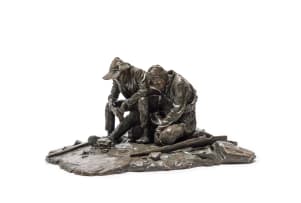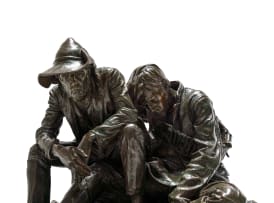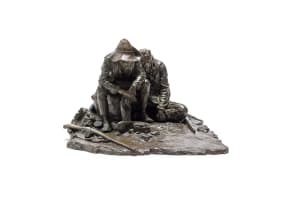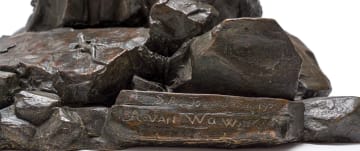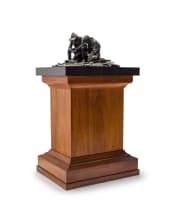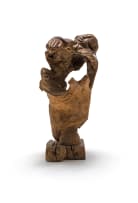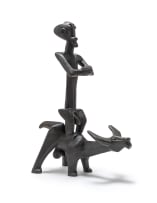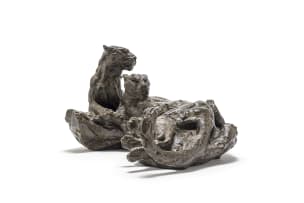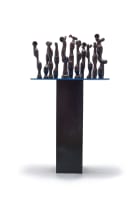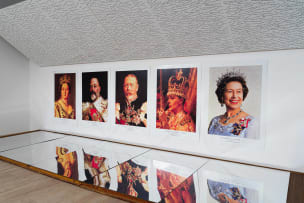Evening Sale
Live Virtual Auction, 28 May 2024
Evening Sale
About this Item
inscribed with the artist's name, 'SA Joh-burg', '1907' and the foundry mark; inscribed with the artist's name, the title, the date, the foundry name, medium and an inscription on a plaque adhered to the base
Notes
Slegte Nuus (Bad News), Anton van Wouw's exquisite and heart-stirring masterpiece, might be the most iconic minimonument of the Boer War. Vivid, tender, recognisable and absorbing, this eloquent and extraordinary bronze is one of the country's cultural treasures. Conceived in 1907 in the artist's Doornfontein studio, during a hot streak of creativity, it was first exhibited in Johannesburg and Pretoria in July 1908, and in London, at the Fine Arts Society Galleries, the following year. The sculpture catches two crestfallen Boer soldiers, broken in body and spirit, but brave and ever-hardy, resigned to the loss of their Republic's independence, or their own impending imprisonment. The moment is agonising and inspirational: one man rests his head on the other, his right ankle snapped and useless, his physical pain buried, and his cartridges mainly spent; the other's stare is dogged and fixed forward, his soft veld hat throwing shadows across his gaunt face, his rifle temporarily downed, and his expression haunted by suffering. This particular casting of Slegte Nuus comes from the furnaces of Giovanni Nisini, the acclaimed foundry on the Via del Babuino in Rome. High-quality Roman castings of the work are desperately rare: only a handful were ordered from Nisini between 1908 and 1924 - with others potentially produced up to 1934 - before the plaster was moved to Giovanni Massa's foundry. The extraordinary Roman foundrymen and patineurs certainly did justice to Van Wouw's touching figural composition and his staggering attention to detail: note the iron sights on the Mauser rifle, for instance, the crumpled corduroy jacket sleeves, the matted beards, holes in soles, and the lizard behind the soldiers, perhaps emboldened by their long, melancholy stillness. The sculpture is a poignant tribute to brotherhood, and an enduring image of courage, grit, and patriotism. The plaque accompanying this casting bears a dedication from Mrs Nancy Cooksey in memory of her husband Fred and only son John. Fred died on 20 November 1984, and John on 17 July 1968.
Literature
AD Keet (1981) Briewe van Anton van Wouw aan A D Keet, Cape Town: Nasionale Pers, illustrated in black and white, unpaginated.
University of Pretoria (1981) Anton van Wouw 1862-1945 en die Van Wouwhuis, Pretoria: Butterworth, another cast from the edition illustrated on page 27, plate A5.
Hans Fransen (1982) Three Centuries of South African Art, Johannesburg: AD Donker, another cast from the edition illustrated on page 327.
AE Duffey (2008) Anton van Wouw: The Smaller Works, Pretoria: Protea Book House, another cast from the edition illustrated on pages 53 to 55.

